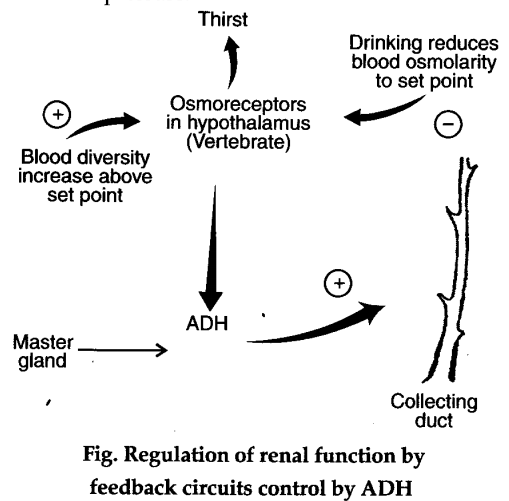Regulation of kidney function by feedback circuits: There are 2 main feedback circuit systems in the vertebrate kidneys : (i) Control by ADH and (ii) Control by JGA.
Moreover there is one extra system called ANF or atrial natriuretic factor.
(a) Control by ADH : (i) The antidiuretic hormone is secreted in the hypothalamus and released into blood by. pituitary part called neurohypophysis. It increases fluid retention by making kidney to reabsorb more water, (ii) Osmoreceptors of hypothalamus detect the osmolarity above 300 mosm L_1. The thrust is produced, (iii) Drinking of water reduces osmolarity of blood, (iv) The secretion of ADH is decreased and the circuit is completed.
(b) Control by JGA : (i) RAAS is operated by juxta glomerular apparatus, (ii) It responds to decrease in blood volume in afferent renal arterioles, (iii) The renin converts angiotensinogen I into angiotensin II which increases blood pressure and causes the arteries to constrict, (iv) In DCT and PCT there is more absorption of NaCl and water, (v) The feedback circuit is completed when the blood pressure is increased and it is supported by release of rennin.
© Control by ANF : (i) This hormone opposses the regulation of kidney7s function by RAAS. (ii) ANF is released from the walls of atria of heart response to increase in blood volume or blood pressure
(iii) ANF decreases the release of renin from JGA. So NaCl reabsorption is inhibited by CT. (iv) It reduces the release of aldosterone from adrenal. Therefore ANF, ADH and RAAS provide a system of check and balance which regulate and control body fluid osmolarity, salt concentration and blood volume or blood pressure.
